
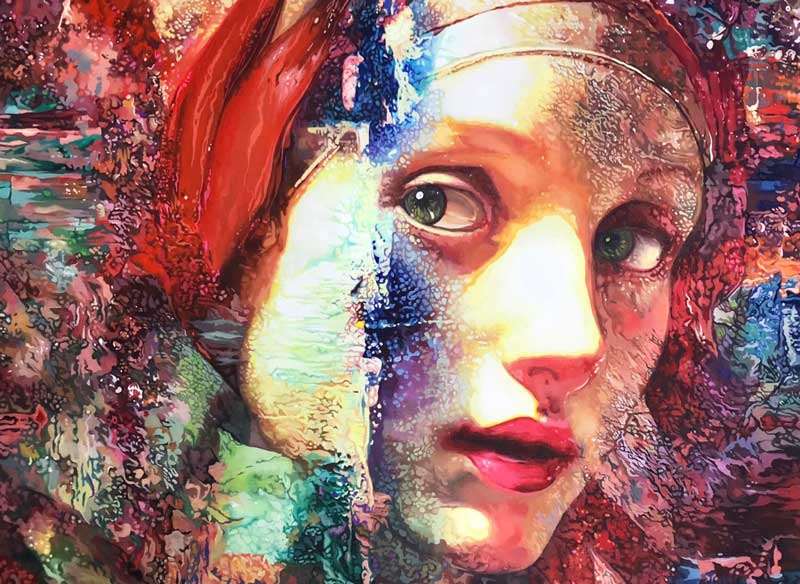
Art has always evolved alongside technology. From the invention of oil paint during the Renaissance to photography and digital tools in the 20th century, every innovation has influenced how artists see and represent the world. Today, the most revolutionary force reshaping creativity is Artificial Intelligence (AI).
AI doesn’t replace the artist—it inspires and challenges them. Contemporary painters across the globe are experimenting with AI-generated images, algorithms, and neural networks as sources of inspiration for their works on canvas. The result is a new dialogue between human intuition and machine intelligence.
For centuries, the relationship between art and technology has been a constant source of innovation. From the invention of oil paints to the advent of the printing press and the camera, each technological leap has opened up new creative possibilities. Today, we are witnessing one of the most transformative fusions yet: the partnership between artificial intelligence (AI) and contemporary painters. Far from replacing human creativity, AI has emerged as a powerful collaborator, a muse for the 21st century that inspires new ideas, processes, and forms of expression.
This new artistic frontier is marked by a fascinating dialogue between algorithms and the human hand. Artists are no longer just creators; they are also curators of digital inspiration, using AI as a tool to explore concepts, generate unique compositions, and even push the boundaries of their own styles.
enaissance: Linear perspective and oil paints revolutionized realism.
19th Century: Photography changed how artists interpreted light and time.
20th Century: Digital tools and video art blurred boundaries between media.
21st Century: AI introduces algorithms that can “imagine” and generate images, offering painters unprecedented new references.
“Every technological leap has expanded the horizons of art. AI is simply the latest and perhaps most radical.”
The fear that AI will replace human artists is a common misconception. In reality, AI acts as a generative engine, capable of processing vast amounts of data and creating outputs that can be stunningly original. For a painter, this means having a collaborator that can offer infinite starting points. An artist can feed an AI program a series of images—say, classical portraits, urban landscapes, and abstract patterns—and ask it to generate something new. The AI might produce a distorted portrait in a style that is both recognizable and alien, or a cityscape with impossible, dreamlike elements.
The beauty of this process lies in the collaborative effort. The AI provides the raw, unrefined idea, but it is the human artist who makes the creative decisions. They choose which images to use, how to interpret the AI’s suggestions, and how to translate a digital concept onto a physical canvas using their unique skill and vision. This human touch—the intentional brushstroke, the choice of color, the application of texture—is what gives the final artwork its soul.
The influence of AI is also giving rise to a new aesthetic. We are beginning to see a style that blends the precision of digital algorithms with the organic imperfections of traditional painting. This is often referred to as hybrid art, and it can be seen in works that feature digital artifacts, pixelated textures, or surreal compositions that are difficult to achieve through traditional means alone.
This hybrid approach allows artists to explore themes that resonate with our increasingly digital world. They can comment on the nature of reality, the relationship between man and machine, and the very definition of creativity in the age of algorithms. The finished piece becomes a physical representation of this digital-first creative process, a testament to the fact that technology and humanity are not opposing forces, but rather intertwined parts of the same artistic journey.
AI is not about machines painting instead of humans—it’s about how artists reinterpret machine-generated suggestions. For example:
Idea Generation: Artists input prompts into AI systems to generate surreal or abstract compositions, later reinterpreting them with traditional painting techniques.
Style Transfer: Algorithms can mimic the styles of masters like Van Gogh or Vermeer, offering painters new hybrid inspirations.
Detail Exploration: AI can create textures and forms that the painter refines on canvas, pushing the boundaries of hyperrealism and abstraction.
Conceptual Art: Painters use AI not just visually but conceptually, reflecting on the relationship between humans and machines.
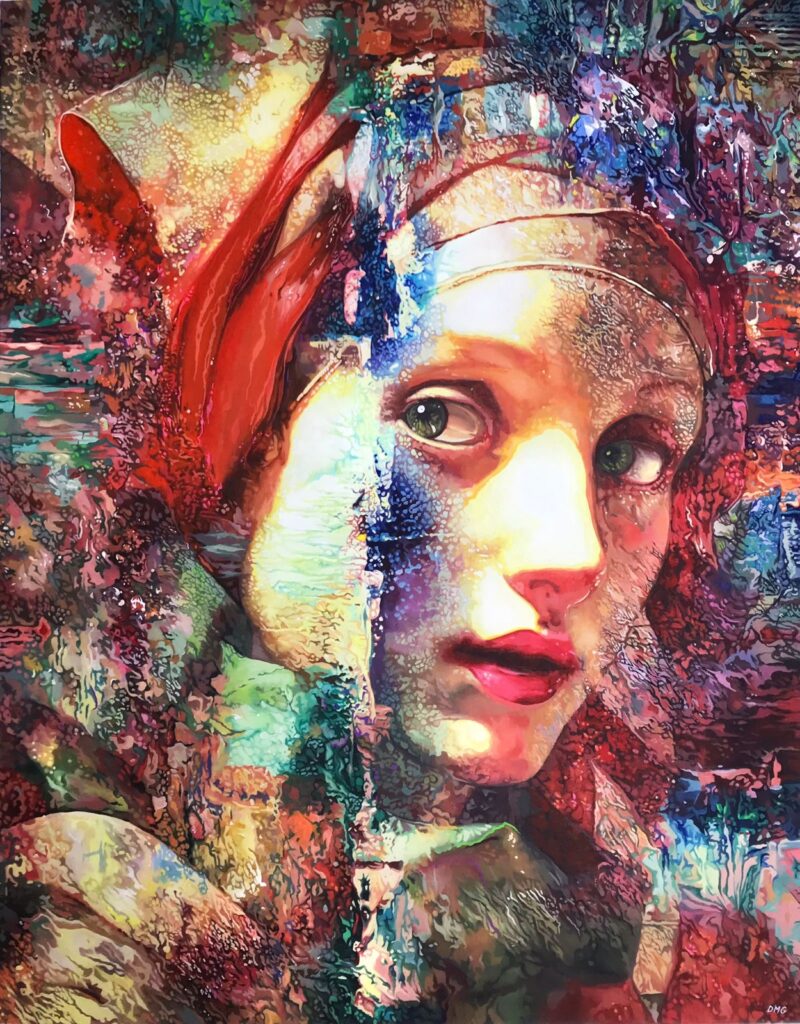
A prime example of this innovative approach is the work featured at Wave Art Gallery, specifically the piece “Odalisque.” This painting is a testament to the collaborative power of AI. It holds a certified world record as the first painting to be suggested by an AI and then recognized by that same AI as a famous masterpiece—Johannes Vermeer’s “Girl with a Pearl Earring.”
The artist used AI as a creative partner, feeding it a dataset that allowed the AI to generate a unique composition. The resulting digital image was then masterfully translated onto canvas using traditional acrylics. The final artwork is not a photorealistic copy but a vibrant and abstract reinterpretation of a classic. It features fragmented lines, bold colors, and a dynamic energy that could only come from this new, hybrid process. The finished piece is a profound commentary on the dialogue between history and technology, and the enduring power of human artistry to transform digital data into emotional resonance.
For more information on the evolving relationship between AI and art, and its place in art history, you can read this academic article from a credible source like the Smithsonian Magazine, which delves into how AI is creating a new form of art.
Critics often ask: If a machine suggests an image, is the human still the artist?
The answer lies in intent. While AI can generate visual material, it lacks human emotion, cultural context, and vision. Painters transform AI outputs into meaningful works by adding human interpretation, emotion, and physical craft.
As noted in The Art Newspaper, artists worldwide are using AI as a tool rather than a replacement, proving that technology expands art rather than diminishes it.
Collaborative Creativity: Artists and AI working together, each bringing strengths—intuition and emotion from humans, speed and data from machines.
New Aesthetics: Hybrid styles that combine digital surrealism with analog craftsmanship.
Market Growth: Collectors are increasingly drawn to AI-inspired works because of their cultural significance and rarity.
Philosophical Questions: What does authorship mean when machines “suggest” art? The debate itself fuels artistic exploration.
Innovation: These works mark a turning point in art history.
Rarity: Each painting represents a unique fusion of machine suggestion and human creativity.
Cultural Value: They embody the contemporary dialogue between technology and humanity.
Conversation Piece: Owning such a work means owning part of the story of the future of art.
he fusion of technology and art has never been more fascinating. AI-inspired paintings do not diminish human creativity—they expand it, offering new tools, visions, and narratives.
At Wave Art Gallery, we celebrate this evolution by presenting works that bridge tradition and innovation. From hyperrealistic portraits to AI-inspired masterpieces, each painting invites collectors to witness the future of art on canvas.
AI refers to algorithms that generate images, which painters then reinterpret with traditional techniques.
No, AI provides inspiration, but the human remains central in creating meaning and emotion.
AI can generate images but lacks human vision, cultural context, and emotion. The artistic value comes when humans interpret it.
Collectors value them as innovative, historically significant works that reflect the era we live in.
Yes, when guided by a human artist who transforms AI suggestions into unique physical works.
Because AI can generate detailed references that hyperrealist painters refine, combining digital inspiration with manual mastery.
AI can act as a tool to generate concepts, compositions, or color palettes. An artist can feed an AI program a set of images, and the AI will produce novel visuals that the artist then interprets and translates into a physical painting.
No, it’s quite the opposite. Using AI can actually enhance originality by providing a source of inspiration that is outside the artist’s traditional creative process, pushing them to explore new styles and ideas.
Yes. The AI is a tool, much like a brush or a camera. The final creative decisions—from the composition and color to the technique and emotion—are made by the human artist, making the work a product of human creativity.
AI-generated art is produced entirely by an algorithm without human intervention. AI-inspired art involves a human artist using AI as a tool to generate ideas, which they then bring to life on a physical canvas.
Hybrid art is a new form of expression that merges digital and traditional art-making processes. It can feature elements that are distinctly digital, such as pixelation or fragmented imagery, within a hand-painted work.
Yes. The value of an AI-inspired painting is determined by the artist’s skill, the originality of the concept, and its place within the art market. Many collectors are interested in works that represent this unique moment in art history.
AI can create images, but the debate on whether it can create “art” on its own is ongoing. Art is often defined by intent, emotion, and human experience, which are qualities an AI does not possess.

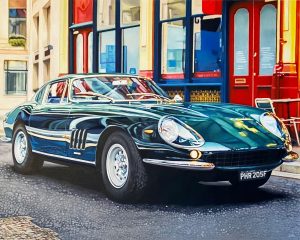
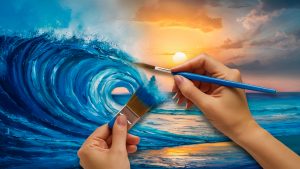
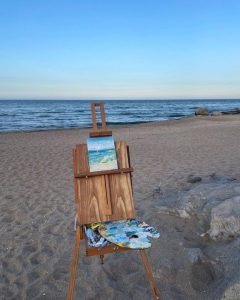
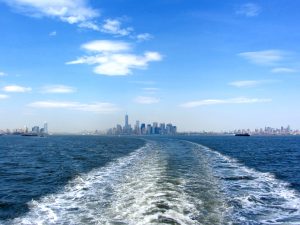
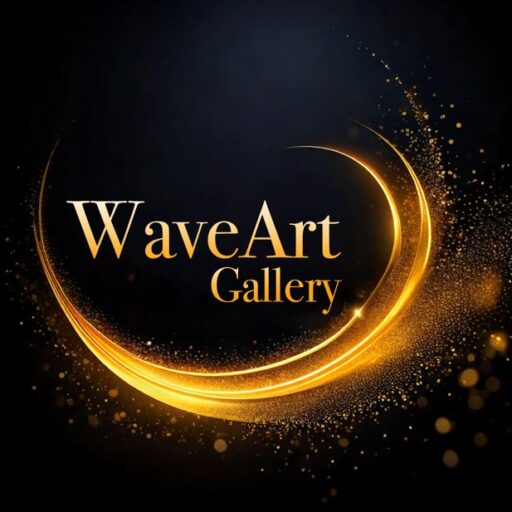
WhatsApp us